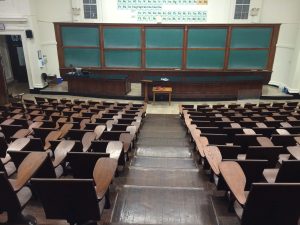I began teaching in the same lecture halls in which I had been an undergraduate student at Berkeley. Yet the rooms in which I eagerly studied anthropology seemed ill-fitted to the subject matter I sought to teach as the instructor of Health Promotion in a College Setting: a large lecture hall was a difficult place to facilitate a discussion about suicide, its uniform chairs unrelated to the diverse experiences students had regarding mental health, and my singular position at the front of the class presumptive of a single-direction approach to the complex and sensitive subject. Nevertheless, despite chairs bolted to the ground, I looked for creative ways to inject engaging experiences into the standardized space: I learned to punctuate class time with one-on-one conversations and to find creative ways for students to ask questions anonymously. Most importantly, I learned the value of creating a safe space for participation. I now teach in a different discipline, yet these lessons reverberate and continue to inform my practice.
Later, while pursuing a Master’s in education, I learned about student-centered teaching practices and methods to help students actively construct—rather than passively receive—knowledge. Yet I also observed a disjunction between these ideas and the physical environment in which I taught and learned; this observation ignited my broader interest in architecture and continues to influence both my practice as a teacher and my work as a scholar.
As a Graduate Student Instructor (GSI) at Berkeley I teach an introductory course to the social and cultural basis of architecture and a survey course of cultural landscapes from 1900 to the present. In the architecture course, my aim is for each student to understand basic concepts in person-environment studies and how they vary by sub-culture, apply these ideas to the design of built environments, and employ social research methods to evaluate the human experience of architecture. In the cultural landscapes course, I strive to ensure students can read a variety of actors and processes in ordinary landscapes past and present and write critically about each using archival sources and built forms as evidence to understand the relationship between cultural groups and their spaces.
My pedagogical choices are informed by both the social and physical contexts of the classroom setting. I change the configuration of furniture to facilitate various activities and I employ both visual and verbal media to productively reinforce key vocabulary and course themes. Further, I seek to develop learning communities at a range of scales; thus I often invite students to work in small groups before sharing findings with the larger class. Through these practices, I aim to identify and engage students’ existing knowledge and interests, relate them to the ‘big ideas’ of the course, and establish the fundamental conceptual and methodological ‘hooks’ on which to hang subsequent learning. For example, when working with students on Edward T. Hall’s concept of proxemics, I invite students to physically act out personal space bubbles and reflect on their previous experiences negotiating these zones in a range of public spaces and in different cultural milieux; in so doing, students embody a basic person-environment concept and learn how these informal zones vary by group and context. To engage with course readings on urban parks and sustainability as a social practice, I ask students to collaboratively sketch a proposed redesign of People’s Park as a sustainable park; this activity allows me to check for student understanding, meanwhile inviting students to learn from each other’s strengths: some are more theoretical than graphic; others more visual than verbal. Additionally, I teach observational methods by having students conduct a brief observation of a campus space; in debriefing their experiences and findings, we discuss methodological points and questions of validity, reliability, and triangulation.
After my first semester as a GSI I was pleased to see how many students praised my enthusiasm for the subject and my ability to inspire interest and engagement in course topics; in fact, I earned the distinction of Outstanding GSI in Fall 2013, an honor reserved for fewer than 10% of Berkeley GSIs annually. However, I realized that lower marks on “knows if students are understanding her” and “emphasizes conceptual understanding and recent developments in the field” meant that I had room to grow. The following year, I made a point of relating course readings to contemporary issues such as a New York Times video that showed how people’s vision changes when they age and an article about “anti-homeless” measures taken in the design of a luxury high-rise in London; these examples prompted thoughtful discussions about designing for vulnerable populations. Additionally, I developed questions to guide students in identifying the main idea and design implications of assigned articles, and periodically asked students to collectively respond to an image of a designed environment and evaluate its suitability for a range of occupants and/or activities using course readings as evidence to support their claims. These activities helped me check for understanding and exposed students to a variety of readings of a single environment. Further, my 2014 course evaluations demonstrated improvement in these two areas; one student wrote: “One of the most helpful things in this course was the questions our GSI gave us…to find…the main ideas of the article” and in 2015, another student said: “[Caitlin] always checks for understanding.”

